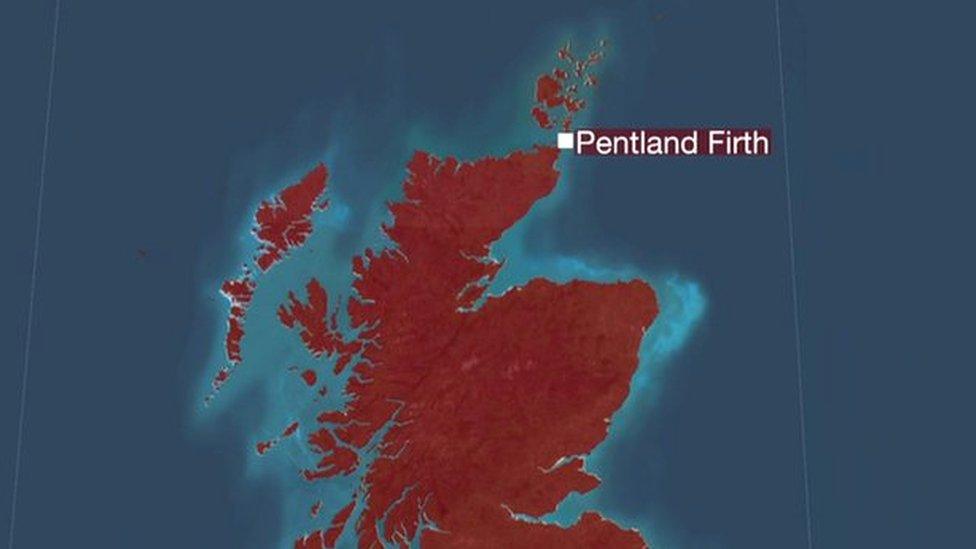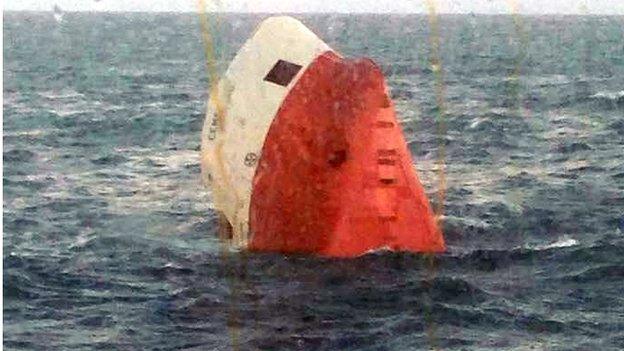Cemfjord sinking: Deaths of eight crew 'could have been avoided'
- Published

A passing ferry raised the alarm
The deaths of eight crew when a ship capsized in the Pentland Firth in violent conditions could have been avoided if the master had instead sought shelter, a report has said.
The Cyprus-registered cargo ship Cemfjord later sank, in January 2015.
The Marine Accident Investigation Branch said the master's decision was "probably influenced by actual or perceived commercial pressures".
The MAIB said the sea conditions were "extraordinarily violent".
The report said there would have been no time to issue a distress message or escape.
The alarm was raised by the NorthLink ferry Hrossey, which was sailing to Aberdeen from the Northern Isles, after the upturned hull was spotted.
Common conditions
The report said: "The investigation found that Cemfjord capsized in extraordinarily violent sea conditions caused by gale force winds and a strong, opposing tidal stream.
"Such conditions are commonly experienced within the Pentland Firth, were predictable and could have been avoided by effective passage planning.
"The master's decision to take Cemfjord into the Pentland Firth at that time was probably influenced by actual or perceived commercial pressures and his personal determination to succeed.
"While it is likely that he underestimated the environmental conditions, his decision to press on would almost certainly have been influenced by his recent experience of a dangerous cargo shift while attempting to abort an approach to the Firth in heavy seas."

A side sonar scan of the wreck was carried out
The report continued: "The rapid nature of the capsize denied the crew the opportunity to broadcast a distress message or abandon their ship.
"The float-free emergency position indicating radio beacon did not work almost certainly because it became trapped in the upturned hull.
"The accident went unnoticed ashore because the vessel's progress through the Pentland Firth was not being monitored and Shetland Coastguard did not require vessels to report when exiting the voluntary reporting scheme area.
"The investigation also established that Cemfjord was at sea with significant safety deficiencies relating to its rescue boat launching arrangements and bilge pumping system in the void spaces beneath the cement cargo holds."
Safety culture
The MAIB said Cemfjord's managing company had implemented several changes and initiatives aimed at "improving the safe operation of its cement carrying vessels and the safety culture of its crews".
No trace of the seven Polish nationals and one Filipino on board the Cemfjord was found despite an extensive search operation.
The crew names were released at a church service held in their memory in Wick in Caithness, as a candle was lit for each, and prayers said for them and their families.
They were named as:
Master Pawel Chruscinski, 43
Chief officer Jaroslaw Orlow, 54
Chief engineer Roman Tamas, 56
Third engineer Jerome Narvas, 32
Ordinary seaman Henryk Dubanowski, 55
Ordinary seaman Tomasz Kwiatkowski, 31
Able seaman Artur Podrazka, 24
Ordinary seaman and cook Artur Wegorek, 24

A survey of the Cemfjord was also done using a remotely operated vehicle

The sinking happened in the Pentland Firth
The 83m Cemfjord had been sailing to Runcorn in Cheshire.
- Published10 February 2015

- Published18 January 2015

- Published15 January 2015

- Published7 January 2015

- Published5 January 2015

- Published4 January 2015

- Published4 January 2015

- Published3 January 2015

- Published3 January 2015
